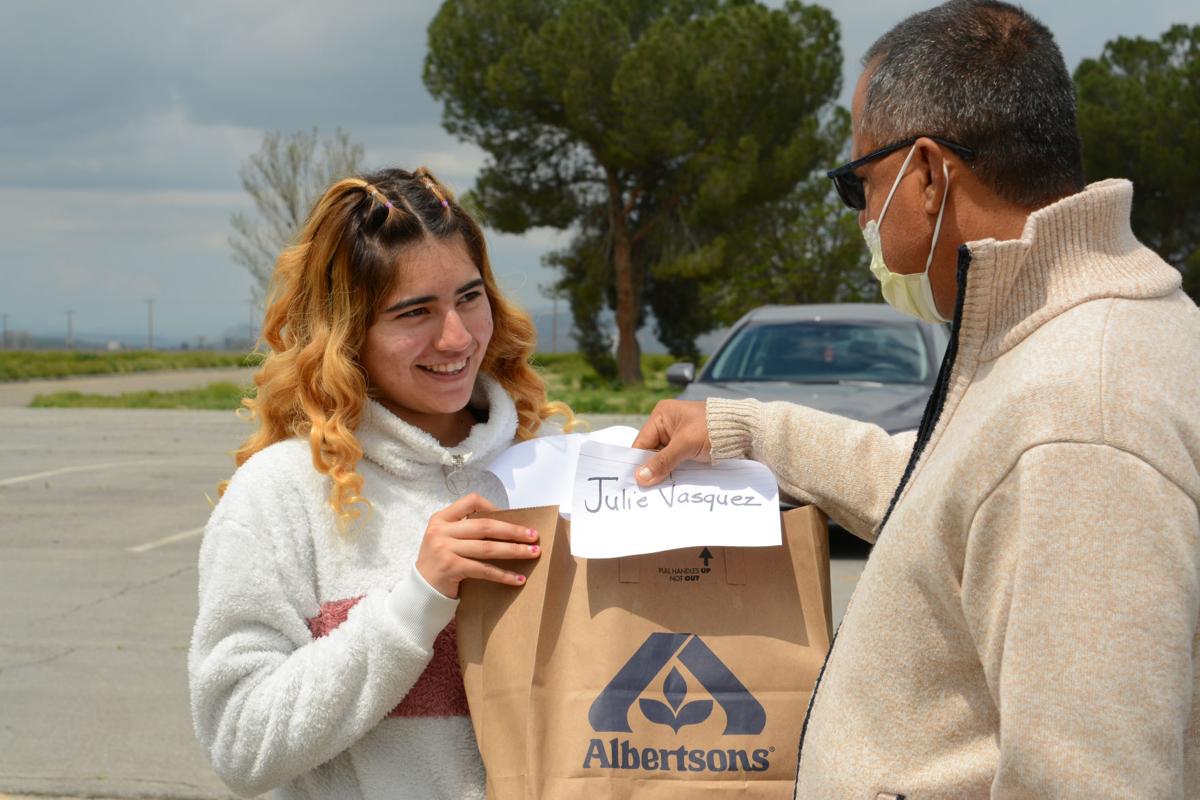Students, teachers working through COVID-19 challenges in Cuyama Valley as school commences

Cuyama Joint Unified School District Superintendent Alfonso Gamino gives a homework packet to Julie Vasquez on April 20. Vasquez graduated in June. The school district is planning to hold classes entirely online
this fall. Photo: Kristen Hwang
Aug 14, 2020
When Cuyama Valley students go back to school Monday they’ll put down their pens and start typing on their keyboards, despite a lack of reliable internet connection in the remote farming region.
Cuyama Joint Unified School District relied on pen and paper after schools closed this spring due to COVID-19, but students’ entire learning experience will now be online.
“This time around, we’re going to be much more structured, we do have funding so that we can get equipment for our kids,” said Alfonso Gamino, district superintendent. “We can provide a much more effective daily instructional program. That’s going to be the difference.”
Cuyama Valley is a 300-square-mile, sparsely populated farming area 60 miles east of Santa Maria, where nearly 40 percent of the population speaks Spanish at home. While schools elsewhere in the state pivoted to online instruction when they closed in mid-March, most of the Valley’s approximately 200 K-12 students could only get reliable high-speed internet access on campus, which had closed.
Due to the lack of broadband internet in the valley, many of the roughly 1,000 people who live there rely on their cell phone data plans or satellite, while others cannot afford internet access at all. About 80 percent of the Cuyama students are socioeconomically disadvantaged and one-third of households earn less than $35,000.
So when schools shut down in March, teachers and staff got together quickly to come up with a response.
“The way we felt to go was to do the pencil [and] paper,” said Rachel Leyland, principal at Cuyama Elementary School. The school phoned parents to tell them the plan, in Spanish as well as English.
Each month, two teachers and the superintendent waited by the curb outside Cuyama Valley High School with a wagon filled with brown paper grocery bags holding the next month’s homework assignments, and accepted the work students had completed. A second drive-thru took place four weeks later.
Laptops for fall
Next week, the school district is planning to give every K-12 student a laptop.
Using the Learning Loss Mitigations Funding it receives from the state, the district purchased 165 student laptops in addition to the 45 laptops it already had and 20 staff laptops for the teachers. The funding, totalling $5.3 billion, includes $539.9 million to help schools mitigate learning loss related to COVID-19 school closures.
Gamino said the Cuyama school district is getting nearly $130,000 in Learning Loss Mitigation funds and another $40,000 through the Local Control Funding Formula, which gives additional state funds to districts based on the number of students who are low-income, English learners, foster or homeless. The total of $170,000 will help pay for the laptops, which cost about $100,000, the hot spots, the educational platforms and applications they will need for online instruction.
Only high school students like Julie Vasquez, who was a senior at the time, were able to check out a laptop this spring. Vasquez graduated in June, but her last months of school were challenging, she said.
Like more than half of Cuyama Valley residents who responded to a community survey, she doesn’t have wi-fi at home. Her teachers were calling, emailing and texting — sometimes multiple times a week — to check in. But she still felt lost, she said.
When she needed to go online at home, she either used her cell phone data plan on the school laptop, or waited until the next day to go to her boyfriend’s house where she could get wi-fi and work on assignments like her agricultural art presentation or join optional Zoom meetings.
During the spring semester, teachers met via Zoom three days a week with 6th to 12th graders who could use their cell phone data plans to access the platform and ask questions about homework.
But some students who cannot afford an unlimited plan could not log in the next day because they had run out of data, said Michael Newman, the high school English, drama, and leadership teacher.
The school hopes to avoid that issue this fall by buying 195 hot spots and giving them to students. They will be able to connect the hot spot to their laptops to amplify the internet signal coming from the campus.
“If you live close to the school, you don’t need that because your computer will be able to detect the signal pretty well,” Gamino said. “It’s if you live very, very far away that maybe the hot spot is going to provide you a little bit stronger connection so you’re able to successfully log in and participate every day.”
Gamino said in an email that teachers have received training on Zoom and access to online resources through the Santa Barbara County Education Office.
“The high school teachers will use the Canvas Learning Management System and the K-8th grade will use the Seesaw Learning Management System for their online programs,” said Gamino in an email. “There will be other Canvas and Seesaw professional development.”
Learning curve for parents
Distance learning in the spring required parents to adapt quickly — like Alicia Muniz and Karla Rodriguez, two Cuyama mothers of four and three, respectively, who put in place a schedule to ensure their children do their homework.
Rodriguez used the schedule the school gave her when she picked up the homework packet and had to shift from using her cell phone data plan to a satellite plan in April. Her connection is now faster, and her kids can access Zoom, she said.
But for those whose children have special needs, which includes about 15 percent of the students in the district, remote instruction was even more challenging — and Cuyama’s reliance on pre-digital media from March to June left some students on their own.
As a non-native English speaker, Fabiola Granados, who owns a local soap store, has been struggling to help her 10-year-old son, who would normally receive speech therapy to help with pronunciation problems.
“I am Mexican,” Granados explained in Spanish, “I understand English, I speak English, but for him, who is a special child, I cannot pronounce the words correctly, and that is where I have struggled a lot.”
Granados and her son still met at least once a week on Zoom with a speech and language therapist that the school arranged for, but she said it wasn’t enough for her son to make progress.
Maria Ramona Carranza, the mother of a 9-year-old special-needs son, said the only guidance she got was general instruction for all students explaining what they needed to do each week.
With special ed classes, he had been doing better, but with the school closed, he found it hard to stay focused, she said. “He is trying very hard to do it,” she said. “We can last up to three hours, but I despair, and I stop doing it. Because if he doesn’t understand me and is not paying attention to me, I’d better stop.”
The Santa Barbara Office of Education, which handles the special education services given in the county including in the Cuyama school district, said that special education has continued to be provided. If someone is not receiving the help they need, a county spokesperson said, they should reach out.
Gamino said in an email that this fall, general education teachers will be providing differentiated instruction through assignments and access to individualized resources that will fit each special education students’ needs. The students will receive at least four hours of support through distance learning with daily interaction and support both individually and in small groups through breakout rooms.
Gamino assured that students with individualized education plans (IEP) will receive the services outlined on their IEPs developed with the student’s individual case manager.
The digital divide isn’t unique to the Cuyama Valley. The state estimates that nearly 20 percent of California students lack high-speed internet or computers.
In northeastern California south of Lake Tahoe, for example, Diamond Valley Elementary School, the largest school in Alpine County, also relied on pre-digital technologies to reach its 80 students, most of them members of the Washoe Tribe. Although the students had Chromebooks, only 10 percent of Alpine households have broadband internet access. The school was distributing packets every other week with readings, activities, and assignments for the students.
The Cuyama Valley district will also receive about $55,000 in CARES funding to buy students and staff face masks, gloves, disinfectant supplies, face shields for teachers and Plexiglass for individual student desks, Gamino said, so the Cuyama schools will be ready when in-person instruction ultimately resumes.





